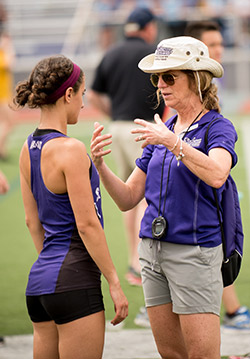 As the pandemic continues to take its toll on the traditions and calendars of higher education, my institution and many others made the decision this summer to cancel fall athletics.
As the pandemic continues to take its toll on the traditions and calendars of higher education, my institution and many others made the decision this summer to cancel fall athletics.
It's a terrible blow. And like so much else we've had to endure, we know competitive sports will return. The sooner, the better because our college athletics, particularly, though not exclusively, in Division II, III and IV schools are a model of so much that we in higher education do best.
Great coaches are great teachers. One of the best parts of watching competitive college athletics is when a coach gathers the players on the sideline. It's best noticed in basketball during a time out. Watch the players' faces as they quickly gather around a coach who is holding their attention, moving her hands around to give direction and sound advice. There's no better place to witness concisely and dramatically what personifies guidance, mentorship, and teamwork.
The sideline moments put on full display the relationship between the teacher and the student. And I see the same look, minus the sweat and adrenaline, as faculty, staff, and students gather to learn.
The teaching and learning that happens in the classroom is only the beginning of a student's education. Homework, independent research, preparing for exams or presentations, experiential learning all serve to extend the classroom experience. Still, so much of our holistic approach to higher education happens in sideline moments. Consider the following interactions:
- For the first time, a reticent student finds the courage to seek out a professor at the end of class to further discuss something that captured their attention, kicking off a lifetime of exploration;
- The moment in the hallway when a first-generation student is asked by a faculty member to conduct research in her lab over the summer – an invitation to join the great scientists on quests centuries in the making;
- The scrum of students who gather around a faculty member at the end of class because they cannot let go of the conversation, the argument, and the questions which only lead to more questions;
- The additional hours a student works with their professor in the art studio, trying to best capture light on canvas, who then come to appreciate the importance of not always applying a filter to the world;
- Students together in the math lab, applying content from their courses, and covering walls with numbers and formulas searching for a solution;
- The first time a student, with guidance from a faculty member and a librarian, accesses primary source material and better appreciates the complexity of history;
- Those moments that happen everywhere on our residential campuses, when a professor, coach, campus minister, resident assistant can recognize in the student the need to talk, right there and then.
 These sideline moments are integral to holistic education. They are personal and, in a very real sense, physical – like athletics for the mind.
These sideline moments are integral to holistic education. They are personal and, in a very real sense, physical – like athletics for the mind.
The pandemic has continued a long debate about the best mode of delivery for higher education. Yes, some content can be delivered online and those courses will be deep, engaging, and enriching. Students can and will learn via digital tools and those tools continue improve, allowing for more and more creativity. But sideline education? That is not easily replicated on the screen.
Many loud voices haven't resisted telling tell colleges and universities what they must do in response to the disruptions caused by the pandemic – then insist that any plan they came up with is unworkable. To be sure, many schools are struggling with their reopening plans.
But other, quieter voices, are trying to safely provide a residential experience that takes into account the sideline moments because we who work with our students gathered around know how vital these moments are to their success in all its manifestations.
We are doing all we can in response to this complex challenge to keep students, faculty, and staff safe. That is our principal obligation. But the time when we huddle together, on the sideline, giving and taking face to face – that can't come back too soon.
Peter Ubertaccio, Ph.D. is the Dean of the Tom and Donna May School of Arts & Sciences at Stonehill College in Easton, MA.








































